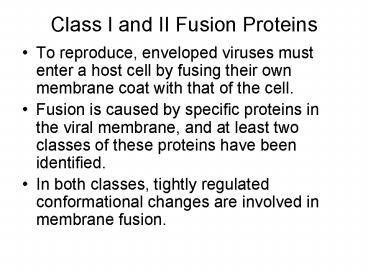Class I and II Fusion Proteins - PowerPoint PPT Presentation
1 / 7
Title:
Class I and II Fusion Proteins
Description:
To reproduce, enveloped viruses must enter a host cell by fusing their own ... they are not cleaved during biosynthesis; and the portion that inserts into the ... – PowerPoint PPT presentation
Number of Views:651
Avg rating:3.0/5.0
Title: Class I and II Fusion Proteins
1
Class I and II Fusion Proteins
- To reproduce, enveloped viruses must enter a host
cell by fusing their own membrane coat with that
of the cell. - Fusion is caused by specific proteins in the
viral membrane, and at least two classes of these
proteins have been identified. - In both classes, tightly regulated conformational
changes are involved in membrane fusion.
2
Class I Fusion Proteins
- Class I fusion proteins are composed of three
identical protein subunits, the functional forms
of which are generated from a precursor that is
cleaved into two pieces. The carboxy-terminal end
of one piece is anchored to the viral membrane
the other end (the new amino terminus) has a
characteristic stretch of 20 hydrophobic amino
acids the fusion peptide. - An essential feature of class I proteins is the
formation of a trimeric helical coiled-coil rod
adjacent to the fusion peptide. This structure
may act as a template for the refolding of
protein segments near to the segments anchored in
the virus membrane.
3
Class I Flu, HIV, Paramyxo
4
Class I Fusion Proteins
- After binding to a receptor on the cellular
membrane, or on exposure to the low pH found in
intracellular compartments (endosomes), the
protein forms an extended conformation and the
hydrophobic fusion peptide inserts into the
target membrane. - Several trimers are thought to be involved.
- Protein refolding begins. The free energy thereby
released causes the membranes to bend towards
each other. - Formation of a restricted hemifusion stalk allows
the lipids in the outer leaflets of the membranes
to mix. - Protein refolding completes, forming the final,
most stable form of the fusion protein,with the
fusion peptide and transmembrane domain
anti-parallel to each other but in the same
membrane.
5
Class II Fusion Proteins
- Class II fusion proteins have distinctly
different structural features they are
predominantly non-helical, instead having a
ß-sheet-type structure they are not cleaved
during biosynthesis and the portion that inserts
into the target membrane is thought to be an
internal hydrophobic fusion loop. - The proteins have a three-domain architecture, in
which domain I begins at the amino terminus,
domain II contains the internal fusion loop, and
domain III is at the carboxy terminus
6
Class II Dengue, Tick-Borne Encephalitis,
Semliki Forest Viruses
7
Class II Fusion Proteins
- The dimeric E protein binds to a cellular
receptor and the virus is internalized to
endosomes. - The acidic pH inside endosomes causes domain II
to swing upward, permitting E monomers to
rearrange laterally. - The fusion loop inserts into the outer leaflet of
the host-cell membrane, enabling trimer
formation. - The formation of trimer contacts extends from the
top to the bottom of the molecule. Domain III
shifts and rotates to create contacts, bending
the membrane. - The formation of further contacts leads to
unrestricted hemifusion and the final most stable
form of the protein.

